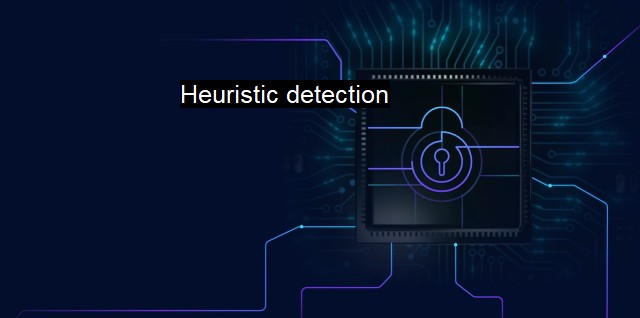What is Heuristic detection?
The Power of Heuristic Detection: Innovative Approach to Identify Emerging Cyber Threats Beyond Traditional Security Solutions
Heuristic detection is a method employed by many computer security program solutions to identify threats and new variations of existing viruses which have not previously been spotted or catalogued in virus definition files. It serves as a proactive approach in combating cyber threats, providing defense systems with an upper hand in a landscape where digital threats regularly evolve.In the practice of computer programming and security, a heuristic is a set of programmed guidelines that conduct analysis and diagnostics to provide a solution to a problem which typically cannot be solved through conventional methods. Heuristic analysis pushes boundaries to surpass ordinary virus identification patterns where detected threats are compared to a directory of known threats. Instead, it intelligently determines the intent and capability of potential threats, examining actions like formulating copies of programming script, dissemination, rewriting scripts, or other behaviors typically practiced by viruses.
Getting its founding ground from principles in problem-solving, heuristic detection in cybersecurity software is intentionally designed to model varying potential strategies that could solve a problem (new infections) by learning or adapting based on experience. A computer security application incorporates heuristics, simulating the abilities of a human brain– working through potential solutions when facing with unidentifiable problems or threats.
By using algorithms involving several factors, heuristic detection extends its reach, making it possible to distinguish between harmless programming scripts and harmful viruses. On top of distinguishing between harmless and harmful scripts, heuristic detection also serves another primary function: early detection. This typically involves the identification of potentially harmful software and isolating them before they cause system infection.
Contrary to static threat detection methods, given the continually evolving landscape of cyber threats, the formation of new viruses regularly occurs. Heuristic detection proves itself in its ability to adapt to these new threats, enhancing antivirus software's capabilities and equipping it with an increased capacity to identify harmful code embedded in worm and virus software that static recognition methods would not necessarily spot.
Heuristic detection is not without its drawbacks. As with any method reliant on a strategic approach, false positives are a notable concern where harmless or benign software is misidentified as harmful or malignant. This can lead to functional applications being disabled or removed in the mistaken belief they are a threat, causing interruptions and inconveniences to the user. Enhancing heuristics processes to strike a delicate balance between being overly unrestrictive (and so less likely to falsely identify benign actions as suspicious) or taking an overly cautious stance (and thus prone to assuming that straightforward actions are malicious and triggering false-positive alerts) might prove challenging.
Heuristic detection logically requires greater computational resources than conventional virus detection methods. As it parses and scans an extensive range of programming code, looking for any signs of suspicious or malicious activities, it can result in a significant increase in system resources being used, affecting the computer's operational speed and efficiency.
Despite these challenges, heuristic detection remains foundational in fortifying cybersecurity infrastructure and antivirus defenses. As the digital space continues to cultivate and welcome newfound complexity and openness, networks and systems can fall victim to yet-unseen malware and cyberattacks. To proactively mitigate enduring modern cyber threats, heuristic detection processes continue to enhance and refine in the perpetual pursuit of robust and dynamic antivirus and cybersecurity protection.
Heuristic detection is an indispensable tool in the cybersecurity software toolbox. By displugging from the conventional approach of an archived repository of recognizable threats, it offers adaptive, anticipative solutions and detectors. It effortlessly identifies threats before the alarm bells ring, setting the foundation for a more aggressive, pre-emptive and able approach towards combating cyber threats in comparison to the traditional virus detection methods.

Heuristic detection FAQs
What is heuristic detection in cybersecurity and antivirus?
Heuristic detection is a technique used by antivirus software to identify and block new and unknown malware threats. It involves analyzing the behavior of a file or program to determine whether it is malicious, rather than relying solely on pre-existing virus signatures.How does heuristic detection work?
Heuristic detection works by analyzing the behavior of a file or program to determine whether it is acting in a malicious manner. This involves looking for suspicious activity such as attempts to modify system files or access sensitive information. If a program is deemed suspicious, it may be flagged and blocked by the antivirus software.What are the benefits of heuristic detection?
The benefits of heuristic detection include the ability to detect and block new and unknown malware threats that may not be identified by traditional virus signatures. This is especially important given the constantly evolving nature of cyber threats. Heuristic detection can also provide a more proactive approach to cybersecurity, helping to prevent attacks before they can cause damage.Are there any limitations to heuristic detection?
While heuristic detection is a powerful tool for detecting new and unknown threats, it is not perfect. False positives can occur, where legitimate programs are flagged as malicious, and false negatives can occur, where malicious programs are not detected. Heuristic detection also requires significant computing resources, which can slow down system performance.| | A | | | B | | | C | | | D | | | E | | | F | | | G | | | H | | | I | | | J | | | K | | | L | | | M | |
| | N | | | O | | | P | | | Q | | | R | | | S | | | T | | | U | | | V | | | W | | | X | | | Y | | | Z | |
| | 1 | | | 2 | | | 3 | | | 4 | | | 7 | | | 8 | | |||||||